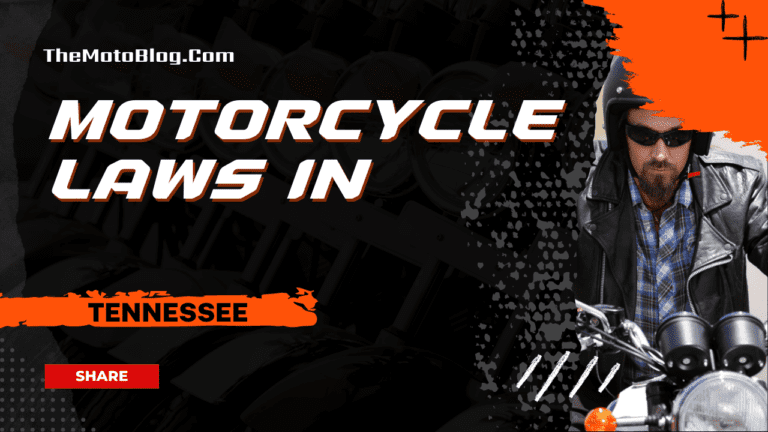Motorcycle Laws in Nevada: Your Comprehensive Guide to Safe Riding
Nevada, the Silver State, is known for its open roads and scenic landscapes that are ideal for motorcycle enthusiasts. However, riding a motorcycle in Nevada comes with its own set of rules and regulations that one must adhere to. I’ll dive into these laws to provide a thorough understanding so you can enjoy your ride while staying on the right side of the law.
First off, Nevada requires all motorcyclists and their passengers to wear helmets that meet standards set by the Department of Transportation – it’s not an option, it’s the law. Furthermore, eye protection is also mandatory unless your bike is equipped with a windscreen or windshield. These laws aren’t just about compliance; they prioritize safety on Nevada roads.
Additionally, lane splitting – riding between two lanes of traffic – isn’t legal in Nevada. This might be surprising as many riders see this practice as a way to navigate through heavy traffic. But remember, when you’re on those wide-open Nevada roads, safety should always take precedence over convenience.
Key Takeaways
- Riding a motorcycle in Nevada is regulated by various laws and regulations for safety purposes.
- All riders and passengers are required by law to wear helmets that meet Department of Transportation (DOT) standards.
- Lane splitting, or riding between lanes of traffic, is illegal in Nevada.
- To legally ride a motorcycle in Nevada, one needs a Class M license, obtainable via a written test and skills test.
- Protective eyewear is highly recommended unless your motorcycle is equipped with windshields.
- Violations of helmet and speeding laws can lead to hefty fines, ranging from $100 to $1,000.
- Reckless driving is a serious offense in Nevada with fines ranging up to $2,000 or six months of imprisonment.
- DUI charges are extremely serious in Nevada, with potential fines and jail time even for first-time offenders.
- Nevada requires motorcycles to carry liability insurance coverage and failure to comply results in penalties.
- Nevada’s motorcycle equipment mandates include specific requirements for helmets, eye protection, footwear and more.
- Accumulating demerit points for traffic violations within a 12-month period in Nevada can lead to license suspension.
Motorcycle laws in Nevada include various regulations that every rider must comply with, such as helmet usage for all riders and passengers, and daytime headlight use, regardless of the weather condition. While these laws are considered standard, a closer look at the neighboring states shows slight differences. For instance, California has specific regulations regarding lane splitting and also mandates helmets for all riders. Moving eastward to Utah, helmets are only required for those under 21, and handlebar height restrictions are in place. In Arizona, riders under 18 must wear a helmet, but adults are exempt. Similarly, Idaho requires helmets only for riders under 18. As seen, while there are common threads in motorcycle safety regulations, unique motorcycle laws are prevalent across Nevada and its neighboring states. Riders crossing state lines would do well to familiarize themselves with these variations to ensure compliance and safe riding practices.
Understanding Nevada’s Motorcycle Laws
Motorcycle laws in Nevada follow a pretty straightforward system. I’ve spent countless hours researching, and here’s what I found out.
First off, helmet use is mandatory for all riders. No matter how experienced you are or how short your ride may be, Nevada law mandates that both drivers and passengers must wear helmets approved by the Department of Transportation (DOT).
In Nevada, lane splitting is strictly prohibited. Well, if you want to drive a motorcycle in Nevada, you’ll need an M endorsement on your driver’s license. To get one, you should pass both written and driving tests specifically related to motorcycles.
Lastly, when it comes to eye protection and passenger regulations, things get a bit more complicated. While not as stringent as helmet rules, protective eyewear is highly recommended for safety reasons.
Helmet Laws in Nevada: What You Need to Know
When it comes to motorcycle safety, helmet laws play a pivotal role. Especially in states like Nevada, where the terrain can be as treacherous as it is beautiful. So let’s dive into what you need to know about helmet laws in this state.
First things first, if you’re planning on riding a motorcycle in Nevada, you’ll definitely need a helmet. It’s not just an option or suggestion – it’s law. All riders and passengers are required by Nevada Revised Statutes (NRS) 486.231 to wear helmets that meet the standards set by the Department of Transportation (DOT).
But what exactly does “meet DOT standards” mean? According to Federal Motor Vehicle Safety Standard 218, a DOT-approved helmet needs:
- A thick inner liner
- Riveted chin straps
- Weight of approximately three pounds
- No protruding objects more than two-tenths of an inch from the surface
It doesn’t matter whether you’re cruising down Las Vegas Boulevard or traversing through uncharted desert roads – if you’re on two wheels with an engine beneath you, your head better be properly protected.
Now let’s talk penalties for violation of these laws. If caught without a proper helmet while riding your motorcycle, your wallet will feel the sting. The fine for first-time offenders ranges from $100 to $250 plus court costs and potentially traffic school too.
Licensing Requirements for Motorcyclists in Nevada
First things first, you’ll need a Class M license. This is specifically designed for motorcycle operators and can be obtained either separately or added to an existing driver’s license.
Here’s a simple breakdown of what you’ll need:
- An application form (Form DMV 002)
- Proof of identity
- Payment for the required fees
- Successful completion of both written and skills tests
For those under 18 years old, there’s an extra requirement – completion of a Motorcycle Safety Foundation (MSF) Basic Rider Course.
| Requirement | Details |
|---|---|
| Application Form | Form DMV 002 |
| Proof of Identity | Driver’s License/State ID |
| Fees | $42.25 Testing Fee + $26.00 Licensing fee |
| Tests Required | (1) Written Test (2) Skills Test |
Now let’s talk about testing. The written test is based on information found in the Nevada Motorcycle Operator’s Manual, which I highly recommend studying before getting behind the wheel…or handlebars! On successful passing of this test, they issue an instruction permit allowing practice rides under specific restrictions.
Next up: The Skills Test – where you’ll showcase your ability to operate a motorcycle safely with proper traffic behavior and hazard response.
Keep these points in mind while preparing for your licensing journey:
- Be aware that Nevada has helmet laws – helmets are mandatory when riding.
- Eye protection is also required unless your bike has windshields.
- Lane splitting isn’t legal yet.
Navigating Nevada’s motorcycle licensing requirements might seem daunting initially but trust me, it gets easier once you start digging into it!
Remember, each step brings us closer to the freedom and thrill that only two wheels can offer!
Rules for Lane Splitting in Nevada
You might be wondering, “Is lane splitting legal in Nevada?” Well, let’s get straight to the point. Lane splitting is not legal in Nevada. Yes, you read that right. If you’re planning a motorcycle ride across the Silver State, it’s important to note this rule.
Lane splitting refers to a motorcycle maneuver where riders drive between lanes of slow-moving or stopped traffic. It’s often seen as a way for motorcyclists to navigate congestion and save time on their commutes. However, each state has its own laws regarding this practice.
Nevada law specifically prohibits lane-splitting under NRS 486.351(2), stating that motorcycles must follow the same rules as other vehicles on the road and cannot pass cars within the same lane.
Here are some key points about Nevada motorcycle laws:
- Motorcycles should occupy an entire traffic lane
- Passing another vehicle within the same lane is prohibited
- Motorcycles may not overtake and pass in a no-passing zone
- Helmets are required for all riders
In contrast with California—the only U.S state where lane splitting is explicitly allowed—Nevada continues to enforce its ban on this practice despite ongoing discussions among lawmakers and bikers alike.
As of now, there haven’t been any updates or changes to these regulations despite repeated lobbying by certain biker groups who argue that lane-splitting can be safe if executed properly.
Importance of Motorcycle Insurance in Nevada
Well, first off, riding without insurance can lead to hefty fines or even license suspension. In 2019 alone, thousands of riders faced penalties for failing to carry proof of insurance.
Here are some key reasons why having motorcycle insurance is so critical:
- Financial Protection: Accidents happen. When they do, it’s reassuring knowing that repair costs won’t drain your bank account. Comprehensive and collision coverages offer this financial safety net.
- Liability Coverage: If you’re at fault in an accident causing damage or injury to others, liability coverage steps in to protect you from potentially devastating out-of-pocket expenses.
- Legal Requirement: As mentioned earlier, Nevada law mandates every rider have minimum levels of liability coverage.
Let me paint a clearer picture with some figures:
| Year | Number of Riders Penalized |
|---|---|
| 2017 | 3,245 |
| 2018 | 3,532 |
| 2019 | 4,012 |
You can see how ignoring this requirement has impacted many riders over the years!
So what’s required by law? At least $15k for bodily injury or death per person per accident; $30k for total bodily injury or death per accident; and $10k for property damage per accident.
While these numbers may seem daunting at first glance, I assure you that investing in motorcycle insurance is not just beneficial—it’s essential! It provides peace of mind on open roads and keeps your pocketbook safe from unexpected expenses.
Motorcycle Equipment Standards in the Silver State
First off, helmets are not just recommended – they’re mandatory. That’s right! It’s illegal to ride a motorcycle without wearing a helmet that complies with the U.S. Department of Transportation (DOT) standards. And it’s not just any old helmet either; your headgear must have both DOT and Snell or American National Standards Institute (ANSI) certification stickers.
Let’s talk about eye protection next. Unless you’re riding a bike equipped with a transparent windscreen extending above eye level, you’ll need to wear goggles or an approved face shield. Now, I’m not saying specs aren’t stylish but according to Nevada law, sunglasses alone don’t cut it.
Now onto something we often overlook – footwear. While Nevada doesn’t explicitly require motorcyclists to wear specific shoes, I’d strongly recommend sturdy footwear that protects against common road hazards and accidents.
Here are some other important equipment requirements:
- Your motorcycle must have at least one headlamp, but not more than two.
- You gotta have at least one tail lamp which is visible from 500 feet behind.
- Reflectors are required on each side of your bike.
- Don’t forget about those turn signals! If manufactured after 1973, turn signals are obligatory front and back.
Lastly, let’s touch base on passenger rules because yes – there are specific guidelines for this too! If you’re carrying someone else along for the ride, make sure your motorbike has footrests and handholds for them – safety first folks.
DUI Laws and Penalties for Motorcyclists in Nevada
When it comes to riding motorcycles, I’ve learned that Nevada’s laws are particularly strict. Especially when alcohol is involved. Nevada has zero tolerance for drunk motorcyclists. If you’re caught operating a motorcycle with a blood alcohol concentration (BAC) of 0.08% or more, you’ll find yourself on the wrong side of the law.
The penalties? They’re quite severe. For first-time offenders, the fines can range from $400 to $1,000, along with mandatory community service hours and participation in a DUI education program. Let’s not forget about the possibility of your license being revoked for 90 days.
| Offense Number | Fine Range | License Revocation |
|---|---|---|
| First | $400 – $1,000 | 90 days |
| Second | $750 – $1,000 | 1 year |
| Third+ | $2,000 – $5,000 | 3 years |
For second-time offenders within seven years, fines increase up to a maximum of $1,000 and you may have your license revoked for one year. But there’s also possible jail time to consider – anywhere between ten days and six months.
If you’re unlucky enough to be caught a third time within seven years? The stakes are even higher. You could face fines ranging from an eye-watering $2,000 up to as much as $5,000. Your license could be revoked for three long years and imprisonment becomes increasingly likely – it could last anywhere from one year all the way up to six.
- It’s important to note that these penalties apply only if no one was injured due to your impaired driving.
- If injury or death occurred as a result of your actions on the road while intoxicated… well… let me tell you – Nevada doesn’t take kindly to such transgressions at all.
How Traffic Violations Affect Motorcyclists in Nevada
First off, you need to know that Nevada operates on a demerit point system for traffic violations. This means that each violation is assigned a certain number of points. If you accumulate too many points within a 12-month period, your license could be suspended – and yes, this applies to motorcycle licenses as well.
| Traffic Violation | Points |
|---|---|
| Speeding (1-10 mph over limit) | 1 Point |
| Running Red Light/Stop Sign | 4 Points |
| Reckless Driving | 8 Points |
For example, if you’re caught speeding over the limit by more than 16 mph but less than 20 mph, that’s four points right there! Get nabbed running a red light? You’re looking at another four points added onto your record.
And here’s where it gets tricky: if you rack up twelve or more demerit points within any twelve-month period, the DMV will suspend your driving privilege (whether car or motorcycle) for six months.
- Remember: It’s not just about fines or getting your license suspended.
- Insurance rates can skyrocket after traffic violations.
- Your riding reputation can also take a hit with law enforcement officials and fellow bikers alike.
Legal Consequences of Not Following Motorcycle Laws in Nevada
Firstly, let’s discuss helmet laws. If you’re caught riding without a proper helmet in Nevada, be prepared for some hefty fines. The exact amount varies, but it can range from $150 to $1,000. And it doesn’t stop there; repeated offenses could even lead to suspension of your driving privileges.
Next up is speeding. Like any other state, Nevada has strict rules against exceeding speed limits. Ignoring them isn’t wise – I’ve seen fines soar up to $1,000 for severe cases! And if you think that’s all there is to it – wait till we get into reckless driving charges.
Now, reckless driving is a serious offense in Nevada and carries with it harsh punishments. You could face a fine of up to $2,000, or worse still – incarceration for six months!
Here are the penalties summarized:
| Offense | Fine | Additional Penalties |
|---|---|---|
| No Helmet | $150 – $1,000 | Possible license suspension |
| Speeding | Up to $1,000 | Points on license |
| Reckless Driving | Up to $2,000 | Six months’ imprisonment |
Let me mention another law strictly enforced by the Silver State – lane splitting (riding between lanes). It may be permitted elsewhere but do this in Nevada and an officer might just slap you with a citation.
Lastly (and most importantly), DUI charges are taken extremely seriously here as well. Even first-time offenders face harsh consequences: potential jail time of two days minimum or community service work for 48-96 hours and compulsory attendance at a DUI school.
Remember folks,
- Wear your helmets
- Stick to speed limits
- Avoid reckless driving
- Lane splitting isn’t allowed
- Don’t drink and ride
Conclusion: Complying with Nevada’s Motorcycle Laws
I’ve spent the last sections of this article breaking down Nevada’s motorcycle laws for you. Now, it’s time to wrap things up.
Respecting and adhering to these rules isn’t just about avoiding fines or penalties—it’s about ensuring your safety and the safety of others on the road. Remember that riding a motorcycle in Nevada requires a valid class M license, proof of insurance, and following helmet laws.
- Class M License: I can’t stress enough how important it is for riders to acquire their Class M license before hitting the open roads in Nevada.
- Insurance: It’s mandatory for all motorcyclists in Nevada to carry liability insurance coverage — no exceptions!
- Helmet Laws: Helmets are your best line of defense against serious injury or even death during an accident. As per law, they’re required at all times when riding.
To make sure you don’t find yourself on the wrong side of the law, here’s a quick rundown:
| Requirement | Details |
|---|---|
| License | Class M |
| Insurance | Liability Coverage |
| Helmet | Required |
Motorcycle laws may seem stringent but remember they’re designed with our welfare in mind. Ensuring we abide by them not only helps us avoid legal trouble but also significantly reduces chances of accidents.
So as we conclude this journey through Nevada’s motorcycle regulations together, my hope is that you’ve gained insight and knowledge that will assist you in complying fully with these laws. Riding a motorcycle can be liberating experience – one filled with excitement and adventure, but let’s make sure it’s also safe!
Motorcycle Laws in the US By States
If you liked this article, then please subscribe to our YouTube Channel for more Bike Videos. You can also find us on Instagram, Twitter and Facebook.
Disclosure: As an Amazon Associate, I earn from qualifying purchases. Read more about Amazon Affiliate Disclaimer.

Vishwanath Mathpati
I am Vishwanath Mathpati, a full-time Blogger and Motorcyclist from Bidar, Karnataka. I love writing about my Motorcycles Stories and Riding Gears on this blog.
Know More About Me.






